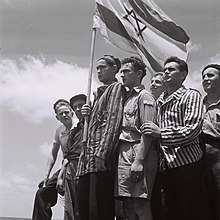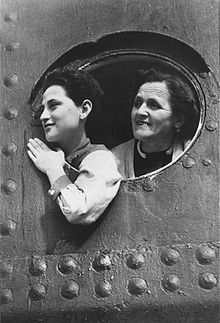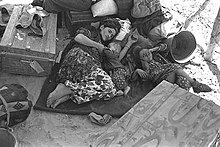
In Jewish history, Jews have experienced numerous mass expulsions or ostracism by various local authorities and have sought refuge in other countries.
The Land of Israel was always regarded by Jews as the Jewish homeland, though throughout most of Jewish history they were barred from the land. After its establishment in 1948, the State of Israel adopted the 1950 Law of Return restoring Israel as the Jewish homeland and making it the place of refuge for Jewish refugees at the time and into the future. This law was intended to encourage Jews to return to their homeland in Israel.
After 1970 the Jackson–Vanik amendment accorded those Jewish emigrants from the Soviet bloc countries who desired to enter the United States refugee status combined with federal assistance in the initial stages of their resettlement.
List of events that prompted major streams of Jewish refugees
- 722 BCE
- 597 BCE
- The Babylonian captivity. In 537 BCE the Persians, who conquered Babylon two years earlier, allowed Jews to return and rebuild Jerusalem and the Temple.
- 70
- The defeat of the Great Jewish Revolt. Masses of Jews were sold to slavery across the Roman Empire, many fled.
- 119
- Large Jewish communities of Cyprus, Cyrene and Alexandria become extinct after the Jewish defeat in Kitos War against Rome. This event caused a major demographic shift in the Levant and North Africa. According to Eusebius of Caesarea the outbreak of violence left Libya depopulated to such an extent that a few years later new colonies had to be established there by the emperor Hadrian just to maintain the viability of continued settlement.
- 135
- The Romans defeated Bar Kokhba's revolt. Emperor Hadrian expelled hundreds of thousands Jews from Judea, wiped the name off the maps, replaced it with Syria Palaestina, forbade Jews to set foot in Jerusalem.
- 629
- The entire Jewish population of Galilee is massacred or expelled, following theJewish rebellion against Byzantium.
- 7th century
- Muhammad expelled Jewish tribes Banu Qaynuqa and Banu Nadir fromMedina,The Banu Qurayza tribe was slaughtered and the Jewish settlement ofKhaybar was ransacked. All three tribes previously had a peace treaty with Muhammad, but they broke the treaty and sided with the opposition. The Banu Qurayza, not only sided with the opposing leaders (The Quraish) but they also waged war against Muhammad.
- 1095 - mid-13th century
- The waves of Crusades destroyed hundreds of Jewish communities in Europe and in the Middle East, including Jerusalem.
- Mid-12th century
- The invasion of Almohades brought to end the Golden age of Jewish culture in Spain. Among other refugees was Maimonides, who fled to Morocco, then Egypt, then Eretz Israel.
- 12th-14th centuries
- France. The practice of expelling the Jews accompanied by confiscation of their property, followed by temporary readmissions for ransom, was used to enrich the crown: expulsions from Paris by Philip Augustus in 1182, from France by Louis IX in 1254, by Charles IV in 1322, by Charles V in 1359, by Charles VI in 1394.
- 13th century
- The influential philosopher and logician Ramon Llull (1232-1315) called for expulsion of all Jews who would refuse conversion to Christianity. Some scholars regard Llull's as the first comprehensive articulation, in the Christian West, of an expulsionist policy regarding Jews.
- 1290
- King Edward I of England issues the Edict of Expulsion for all Jews from England. The policy was reversed after 365 years in 1655 by Oliver Cromwell.
- 1348
- European Jews were blamed for poisoning wells during the Black Death. Many of those who survived the epidemic and pogroms were either expelled or fled.
- 1492
- Ferdinand II and Isabella I issued the Alhambra decree, General Edict on the Expulsion of the Jews from Spain (approx. 200,000), from Sicily (1493, approx. 37,000), from Portugal (1496) from Calabria Italy 1554. It is important to note that this event happened on Tisha B'Av, as with many other events in Jewish history.
- 1654
- The fall of the Dutch colony of Recife in Brazil to the Portuguese prompted the first group of Jews to flee to North America.
- 1648-1654
- Ukrainian Cossacks and peasants led by Bohdan Khmelnytsky destroyed hundreds of Jewish communities and committed mass atrocities. Ukraine was annexed by the Russian Empire, where officially no Jews were allowed.
- 1744-1790s
- The reforms of Frederick II, Joseph II and Maria Theresa sent masses of impoverished German and Austrian Jews east. See also: Schutzjude.
- 1881–1884, 1903–1906, 1914–1921
- Repeated waves of pogroms swept Russia, propelling mass Jewish emigration (more than 2 million Russian Jews emigrated in the period 1881-1920). DuringWorld War I, some 250,000 Jews were transferred from western Russia. See alsoPale of Settlement, May Laws, Russian Civil War.
- 1933-1957
- The German Nazi persecution started with theNazi boycott of Jewish businesses in 1933, reached a first climax during the Kristallnachtin 1938 and culminated in the Holocaust of theEuropean Jewry. The British Mandate of Palestine prohibited Jewish emigration to Palestine Mandatory Palestine. The 1938 Evian Conference, the 1943 Bermuda Conferenceand other attempts failed to resolve the problem of Jewish refugees, a fact widely used in Nazi propaganda (see also MS St. Louis). Many German and Austrian Jewish refugees from Nazism emigrated to Britain were many well treated, but many weren't[1] and many fought for Britain in the Second World War. After WW-II eastern european Holocaust survivors migrated to the allied controlled part of Europe as the Jewish society to which most of them belonged did not exist anymore. Often they were lone survivors consumed by the often futile search for other family and friends, and often unwelcome in the towns from which they come. They were known as displace persons (also known as Sh'erit ha-Pletah) and placed in displaced persons camps, most of which were by 1951 closed. The last camp Föhrenwald was closed in 1957.
- 1947-1972
-
The Jewish exodus from Arab and Muslim countries, in which the combined population of Jewish communities of the Middle East andNorth Africa (excluding Israel) was reduced from about 900,000 in 1948 to less than 8,000 today, and approximately 600,000 of whom became citizens of Israel. The history of the exodus is politicized, given its proposed relevance to a final settlement Israeli-Palestinian peace negotiations.[2] [3] [4] [5] [6] [7] [8]When presenting the history, those who view the Jewish exodus as equivalent to the 1948 Palestinian exodus, such as the Israeli government and NGOs such as JJAC and JIMENA, emphasize "push factors", such as cases of anti-Jewish violence and forced expulsions,[2] and refer to those affected as "refugees".[2] Those who argue that the exodus does not equate to the Palestinian exodusemphasize "pull factors", such as the actions of local Jewish Agency for Israel officials aiming to fulfil the One Million Plan,[4] highlight good relations between the Jewish communities and their country's governments,[6] emphasize the impact of other push factors such as thedecolonization in the Maghreb and the Suez War and Lavon Affair in Egypt,[6] and argue that many or all of those who left were not refugees.[2] [4]
Then UNHCR announced in February 1957 and in July 1967, that these Jews who had fled from Arab countries "may be considered prima facie within the mandate of this office," so according them in international law, as bona fide refugees.[9]
- 1960s-1989
- Due to the 1968 Polish political crisisthousands of Jews were forced by the communist authorities to leave Poland. See also rootless cosmopolitan, Doctors' plot,Jackson-Vanik amendment, refusenik,Zionology, Pamyat.
- 1970s
- State-sponsored persecution in the Soviet Union prompted tens of thousands of Soviet Jews to emigrate to Israel, and some also to the United States with "refugee" status.
- 1979-1980s
- Iranian Jews were persecuted by the Islamic Republic of Iran.
See also
- History of antisemitism
- Timeline of antisemitism
- Timeline of Jewish history
- Jewish diaspora
- Jewish history
- The Holocaust
- Hirsch Schwartzberg
- Population transfer
- Antisemitism
- Christianity and antisemitism
- Islam and antisemitism
- Arabs and antisemitism
- Underground to Palestine
References
- http://phys.org/news/2013-02-british-jews-nazis-myth.html
- Changing tack, Foreign Ministry to bring 'Jewish refugees' to fore ""To define them as refugees is exaggerated,” said Alon Liel, a former director-general of the Foreign Ministry"
- Changing the refugee paradigm
- Israel scrambles Palestinian 'right of return' with Jewish refugee talk "Palestinian and Israeli critics have two main arguments: that these Jews were not refugees but eager participants in a new Zionist state, and that Israel cannot and should not attempt to settle its account with the Palestinians by deducting the lost assets of its own citizens, thereby preventing individuals on both sides from seeking compensation."
- Philip Mendes The causes of the post-1948 Jewish Exodus from Arab Countries
- Yehouda Shenhav The Arab Jews: A Postcolonial Reading of Nationalism, Religion, and Ethnicity
- Avi Shlaim No peaceful solution
- A new hasbara campaign: Countering the 'Arab Narrative'
- http://www.gatestoneinstitute.org/3498/jewish-refugees
External links
- Ordinary exile, the story of Austrian Jewish refugees in France and in Belgium
- A Lifes Worth of Living by Lys Anzia. WNN - Women News Network
- Silent Exodus, a documentary by Pierre Rehov on YouTube





No comments:
Post a Comment